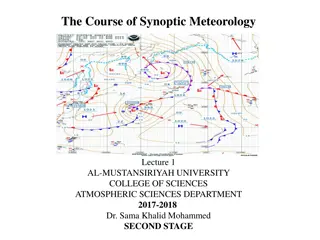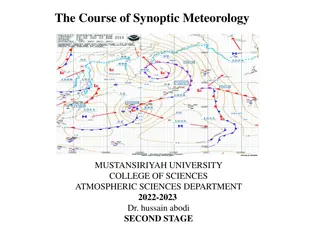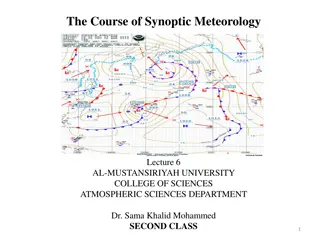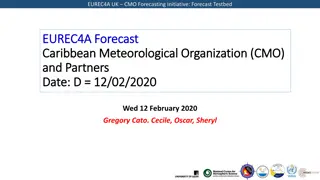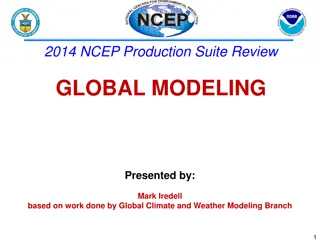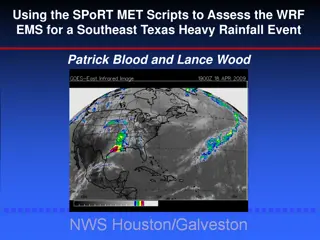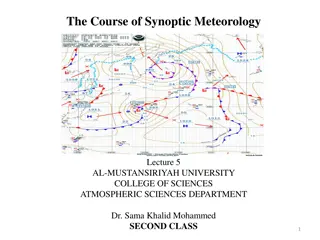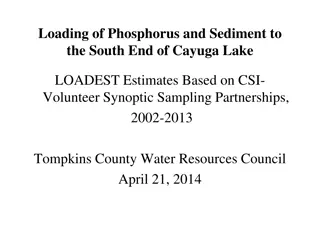Weather Map Interpretation
Weather maps provide data on various weather elements at a specific time. They show isobars, wind direction, cloud cover, rainfall, and more. Weather maps differ from synoptic charts which provide additional detailed information. Analyzing weather maps helps predict weather trends.
6 views • 7 slides
Understanding Synoptic Meteorology: A Comprehensive Overview
Synoptic meteorology delves into various aspects of atmospheric sciences, encompassing scales of atmospheric motion, weather maps, air masses, fronts, jet streams, and more. Through the study of synoptic meteorology, meteorologists gain insights into interpreting the state of the troposphere and for
1 views • 17 slides
International Baccalaureate British Section Language and Literature Exam Details
This detailed guide outlines the structure and content of the International Baccalaureate British Section Language and Literature Exam. It covers the choice of works, written exam requirements, oral exam format, and synoptic topic discussion. Students will find information on the types of texts, ess
0 views • 11 slides
Exploring the Fundamentals of Synoptic Meteorology at Mustansiriya University
Dive into the course of Synoptic Meteorology offered at Mustansiriya University with topics covering atmospheric motion scales, weather maps, air masses, fronts, and jet streams. Learn how to analyze and interpret weather data through the study of high and low-pressure systems, jet streams, and more
0 views • 17 slides
Understanding Synoptic Meteorology: Fronts and Weather Phenomena
Fronts are boundary surfaces that separate air masses of different densities, leading to various meteorological phenomena. Cold fronts, warm fronts, occluded fronts, and stationary fronts impact weather patterns differently, affecting temperature, moisture levels, and wind direction. Understanding t
0 views • 22 slides
EUREC4A UK CMO Forecasting Initiative: Weather Forecast Details
Detailed weather forecast information for the Caribbean region provided by the EUREC4A UK CMO Forecasting Initiative. The forecast covers various parameters including surface analysis, synoptic charts, moisture content, wind speeds at different levels, sea conditions, and more. Updates on winds, hum
0 views • 10 slides
Cadence for Supernovae in LSST and Dark Energy Hubble Diagrams
This content discusses the cadence for supernovae observations in the Large Synoptic Survey Telescope (LSST) and presents Hubble diagrams related to Supernovae and Dark Energy research. The images and descriptions focus on cosmological aspects, distance moduli, observational strategies, and constrai
0 views • 21 slides
Evolution and Challenges in Cloud Resolving NWP Models
Explore the evolution and challenges faced in cloud-resolving Numerical Weather Prediction (NWP) models over the past 50 years. Discover key milestones, such as the development of climate models and data assimilation systems, alongside persistent issues in predicting warm season phenomena and tropic
0 views • 45 slides
Overview of 2014 NCEP Production Suite Review on Global Modeling
The 2014 NCEP Production Suite Review highlighted the significant implementation of the 13 km Global Forecast System (GFS). This major update involved substantial enhancements in resolution, observations, analysis, and physics, impacting various NCEP models and centers. The improved 13 km GFS brough
0 views • 20 slides
Assessing WRF EMS for Texas Heavy Rainfall Event
Using the SPoRT MET Scripts, researchers analyzed the WRF EMS for a heavy rainfall event in Southeast Texas. The study emphasized the importance of selecting appropriate PBL and Microphysics settings for accurate assessment. Various synoptic overviews and weather data from April 18th, 2009 were used
0 views • 26 slides
Understanding Air Masses in Synoptic Meteorology
Air masses are large bodies of air with uniform temperature and moisture conditions, influencing weather patterns across vast regions. Source regions play a key role in determining the characteristics of air masses, with factors such as stability of atmospheric circulation and surface properties sha
1 views • 17 slides
Estimation Methodology for Phosphorus and Sediment Loading in Cayuga Lake Watershed
Explore the process of estimating phosphorus and sediment loading at the south end of Cayuga Lake using LOADEST methodology. Learn how to combine synoptic monitoring data with USGS flow measurements and run calculations to obtain yearly load numbers. Get step-by-step instructions and access helpful
0 views • 13 slides
Weather Forecast Details for Madagascar
Satellite images, synoptic charts, analysis, wind patterns, and precipitation forecasts for Madagascar show a generally calm weather scenario with light winds and few showers expected over the northern part in the upcoming days. The western coast may experience warmer temperatures. No extreme weathe
0 views • 12 slides

